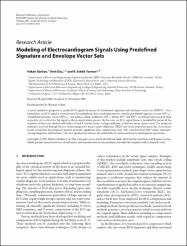Modeling of electrocardiogram signals using predefined signature and envelope vector sets
Künye
Gürkan, H., Güz, Ü. & Yarman, B. S. B. (2007). Modeling of electrocardiogram signals using predefined signature and envelope vector sets. Eurasip Journal on Advances in Signal Processing, 2007, 1-12. doi:10.1155/2007/12071Özet
A novel method is proposed to model ECG signals by means of "predefined signature and envelope vector sets (PSEVS)." On a frame basis, an ECG signal is reconstructed by multiplying three model parameters, namely, predefined signature vector (PSV)(R)," "predefined envelope vector (PEV)(K)," and frame-scaling coefficient (FSC). All the PSVs and PEVs are labeled and stored in their respective sets to describe the signal in the reconstruction process. In this case, an ECG signal frame is modeled by means of the members of these sets labeled with indices R and K and the frame-scaling coefficient, in the least mean square sense. The proposed method is assessed through the use of percentage root-mean-square difference (PRD) and visual inspection measures. Assessment results reveal that the proposed method provides significant data compression ratio (CR) with low-level PRD values while preserving diagnostic information. This fact significantly reduces the bandwidth of communication in telediagnosis operations. Copyright (c) 2007 Hakan Gurkan et al. This is an open access article distributed under the Creative Commons Attribution License, which permits unrestricted use, distribution, and reproduction in any medium, provided the original work is properly cited.
Kaynak
EURASIP Journal on Advances in Signal ProcessingCilt
2007İlgili Öğeler
Başlık, yazar, küratör ve konuya göre gösterilen ilgili öğeler.
-
On the effects of random timing jitter on spectrum sensing algorithms based on cyclostationarity
Öner, Mustafa Mengüç (IEEE, 2009)Cognitive radio is an enabling technology, which is expected to lead to a more efficient utilization of the available spectral resources due to its flexibility and its ability to sense its spectral environment. Recently, ... -
On the spectral correlation of UWB impulse radio signals
Öner, Mustafa Mengüç (IEEE-INST Electrical Electronics Engineers Inc, 2008-10)Cyclostationarity is an inherent characteristic of many communication signals, which can be exploited for performing various signal processing tasks. Determining the cyclic statistics of a signal of interest is often ... -
An efficient ECG data compression technique based on predefined signature and envelope vector banks
Gürkan, Hakan; Güz, Ümit; Yarman, Bekir Sıddık Binboğa (IEEE, 2005)In this paper, a new method to compress ElectroCardioGram (ECG) Signal by means of "Predefined Signature and Envelope Vector Banks-PSEVB" is presented. In this work, on a frame basis, any ECG signal is modeled by multiplying ...


















